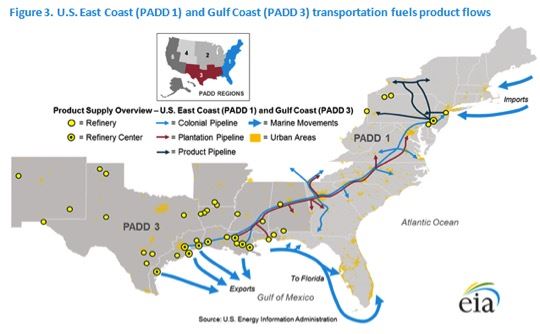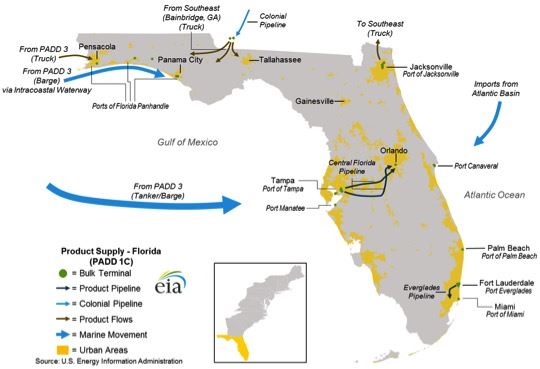The Energy Information Administration (EIA) reports that Hurricane Harvey significantly disrupted the oil and petroleum product supply chains. Inputs to Gulf Coast refineries dropped by 34% between August 21 and September 1, 2017. Texas is home to 31% of the United States' refining capacity, supplying petroleum products to the Gulf Coast, East Coast, Midwest, and international markets. Hurricane Harvey caused many refineries in the region to reduce or shut down production. The Colonial Pipeline, which runs from Houston to New York Harbor and connects 29 refineries and 267 distribution terminals while carrying 2.5 million barrels per day of gasoline, diesel, and jet fuel, was forced to reduce shipping amounts and frequency due to low petroleum supplies. These disruptions caused gasoline drawdowns all along the East Coast and gasoline prices to increase. While gas prices typically rise for travel on Labor Day Weekend, the prices were exacerbated by Hurricane Harvey's impact to the supply chain.

Two weeks later, the disrupted supply chain hindered people trying to escape Hurricane Irma in Florida. Closed shipping ports led to fuel shortages and high gas prices which prevented many people from being able to smoothly evacuate from Irma's path. Even though the Secretary of Homeland Security waived the Jones Act temporarily allowing foreign-flag vessels to bring fuel from other eatern U.S. ports to South Carolina, Georgia, Florida, and Puerto Rico to reduce fuel shortages. At the height of Hurricane Irma, 59% of Florida customers experienced power outages.

How Did Climate Change Play a Role?
While climate scientists and meteorologists are still running attribution studies to determine the level of impact greenhouse gases had on Hurricane Harvey and Irma, other factors can be assessed more easily. NASA and NOAA were both measuring the ocean temperature across the Atlantic and Gulf of Mexico along the hurricane paths. Both bodies of water had surface temperatures of 30ºC/86ºF, which is warm enough to feed a category 5 hurricane. Hurricane Harvey made landfall as a category 4 hurricane, sustaining 130 mph winds, while Hurricane Irma broke the record for longest sustained category 5 winds (over 157mph) as it crossed the Caribbean islands, sustaining 185 mph winds.
Hurricane Harvey's maximum storm surge was 12 feet above ground level, while other areas of South Texas experienced 3-6 feet storm surge. Southeast Texas experienced high levels of rain, with some areas getting over 40 inches within 48 hours. The maximum rainfall during Harvey was 51.88 inches, which broke the North American single rainfall event record.
Hurricane Irma stretched from the east coast to the west coast of Florida, causing water to recede from the coast on the west, while causing an average 4 feet of storm surge on the southeast coast and seven feet of storm surge on the northeast coast. However, that storm surge is on top of the 10-12 inches of sea level rise along Florida's east coast in the last century, allowing additional areas to be flooded.
Another record Hurricanes Harvey and Irma created was having two category 4 hurricanes make landfall in the United States in the same year. Only 27 category 4 or stronger hurricanes have been documented in the United States since 1851, including Harvey and Irma. Hurricane season begins June 1 and continues until November 30 each year, so there is still plenty of time for additional devastating hurricanes to hit. Axios is reporting estimates of Hurricane Harvey having caused between $65-$75 billion worth of damage, while Irma is estimated to have caused $50 billion, together totaling around $120 billion in hurricane damages for 2017 so far (this does not include damage estimates for Puerto Rico or the U.S. Virgin Islands). When adjusted to today's prices, Hurricane Katrina (2005) is still the most expensive hurricane at $160 billion.
While climate change may impact each hurricane differently, we can all be sure there will be more storms of Harvey and Irma's magnitude, with more records broken in the future as our climate systems continue to change. We can already see this occurring as Hurricane Maria is causing catastrophic damage to Puerto Rico and other Caribbean islands as a Category 5 hurricane, when just weeks prior they were hit with devastating Hurricane Irma, also a Category 5 hurricane. 2017 is the sixth year on record to have multiple category 5 hurricanes, with additional storms currently gaining strength in the Atlantic.